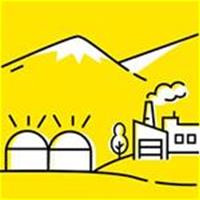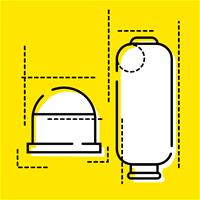
SMRs / mini reactors: a boon for the nuclear sector
SMRs and AMRs gaining momentum worldwide

SMRs* and AMRs** are small modular reactors with lower-power ratings, generally between 20 and 300 MWe per unit, whereas current reactors for electricity production generally start at 900 MWe and extend up to 1650 MWe in the case of EPRs. The vast majority of SMRs are light water reactors, like the reactors currently in operation, whereas AMRs have varying technologies. What sets all these mini-reactors apart is that they are modular: the different parts are designed to be manufactured in series in the factory and then assembled on site. More compact, less time-consuming and less costly to manufacture but still safe, these low-power reactors complement the high-power nuclear range.
Because of their size, SMRs and AMRs will contribute to the faster deployment of low-carbon energy around the world. They are complementary to large and medium power reactors
The concept has met with a strongly positive worldwide response and in 2022 the International Atomic Energy Agency (IAEA) identified more than 80 SMR and AMR projects worldwide (of which 40% are AMR designs), including in the US, Canada, China, Russia and the UK.
Among the many SMR projects under development are NuScale and Holtec in the US, Rolls-Royce in the UK, the Russian RITM-200 , the Chinese ACP 100 , the Korean iSMR model and NUWARDTM in France.
As part of the plan to reactivate France's nuclear program, as announced by President Macron in February 2022, €1 billion of investment will be allocated to the development of innovative small-scale react
SMRs and AMRs: promising features
The purpose of mini reactors is not to replace large-scale power plants but to produce low-carbon, safe and competitive electricity, by integrating into smaller power grids and in remote areas, with the promise of energy autonomy. For example, SMRs and AMRs will be able to replace coal-fired power plants, which emit large amounts of CO2, in many countries.
They also aim to supply electricity to industrial complexes, which are large consumers of heat and electricity, such as the steel, petrochemical and metallurgical industries.
The market for SMRs and AMRs is large, since in countries open to civil nuclear power, more than 3,300 coal-fired units will have to be replaced by 2050
But in addition to supplying electricity, these new generations of reactors will allow other uses such as producing heat. This is an advantage for industrial companies seeking to decarbonize their heating needs, which are currently met by gas. They can also open up other functionalities such as producing fresh water by feeding desalination plants, decarbonizing hydrogen production and providing synthetic fuels. District heating is also one of the possibilities offered by SMRs and AMRs, as evidenced by the studies carried out in Finland to replace district heating networks with SMRs, thus reducing the use of fossil fuels.
Beyond their flexibility and modularity, the promising concepts of small innovative reactors will be able to produce electricity and heat.
SMRs: deployment by 2030
The first examples of the most mature SMR models, based on 3rd generation technologies, are expected by 2030. Beyond the technical aspects, the challenge of deploying SMRs and AMRs lies in their safety and the ability to manage their used fuels.
In terms of nuclear safety, their small size makes it possible to integrate passive safety systems that meet all the safety requirements of 3rd generation reactors. The International Atomic Energy Agency (IAEA) as well as national safety authorities are closely monitoring the certification process of SMRs and AMRs and the harmonization of nuclear safety standards at European and international level.
As regards used fuel management, the ability to process and recycle fuel from operating reactors is an opportunity for SMRs. In the case of AMRs, back-end fuel cycle management is integrated from the design stage. Some of them will make it possible to reduce the volume and radiotoxicity of the long-lived waste.
The promise of Advanced Modular Reactors (AMRs**)

The first examples of the most mature SMR models, based on 3rd generation technologies, are expected by 2030. Beyond the technical aspects, the challenge of deploying SMRs and AMRs lies in their safety and the ability to manage their used fuels.
In terms of nuclear safety, their small size makes it possible to integrate passive safety systems that meet all the safety requirements of 3rd generation reactors. The International Atomic Energy Agency (IAEA) as well as national safety authorities are closely monitoring the certification process of SMRs and AMRs and the harmonization of nuclear safety standards at European and international level.
As regards used fuel management, the ability to process and recycle fuel from operating reactors is an opportunity for SMRs. In the case of AMRs, back-end fuel cycle management is integrated from the design stage. Some of them will make it possible to reduce the volume and radiotoxicity of the long-lived waste.
Molten salt reactors (MSRs)
The molten salt reactor is a very promising technology, with a high energy yield, flexibility of use and, and, especially when used in the fast neutron spectrum, the ability to burn minor actinides, which have been thought of as waste until now because they have hitherto not been recycled. This concept really opens up new perspectives for reducing the volume and radiotoxicity of long-lived waste.though the feasibility of this technology has not yet been determined, Orano is actively contributing to the emergence of these new types of reactors by cooperating with ecosystems of start-ups and partners, particularly in France, the Netherlands and the United States.
A 2040-2050 horizon time?
The industrial and commercial availability of 4th generation reactors will have to wait until 2040 or even 2050. What is certain is that the proliferation of initiatives worldwide, the unprecedented volume of investment and the competition between developers will lead to technological breakthroughs and a possible acceleration of the design and development phases.
Which fuels for innovative reactors?

There are multiple fuel families, adapted to the different types of 4th generation reactors. Depending on the reactor technology, the nature of the fissile material contained in the fuel, its chemical form and its geometry will vary greatly. Thus, fuels based on HALEU (High-Assay Low-Enriched Uranium), plutonium, or even other actinides in solid (oxide pellets, metal, TRISO beads) or liquid (molten salt) form could be developed.
As an expert in the fuel cycle, Orano wishes to support the development of new reactor concepts by supplying fuel with properties that will enable it to achieve a satisfactory level of safety and a competitive production cos
*SMR : small modular reactor
**AMR : advanced modular reactor
***RSF/MSR : molten salt reactor
Crédit picture © EDF
- Nuclear Industry, an Economic Asset The nuclear industry represents the 3rd French industrial sector after the aeronautics and automotive sectors.
- Nuclear fission and fusion: what you need to know Let's take another in-depth look at the nuclear technologies capable of generating clean and low-carbon energy: nuclear fission generating our electricity today and the future of energy with nuclear fusion.
- Nuclear energy: an asset for France’s energy independence According to a recent BVA survey for Orano* on how the French public perceives nuclear energy, 53% of respondents consider it to be essential for France’s energy independence. And it’s true! Nuclear energy gives France an energy independence of 56%, one of the highest independence rates in the European Union.